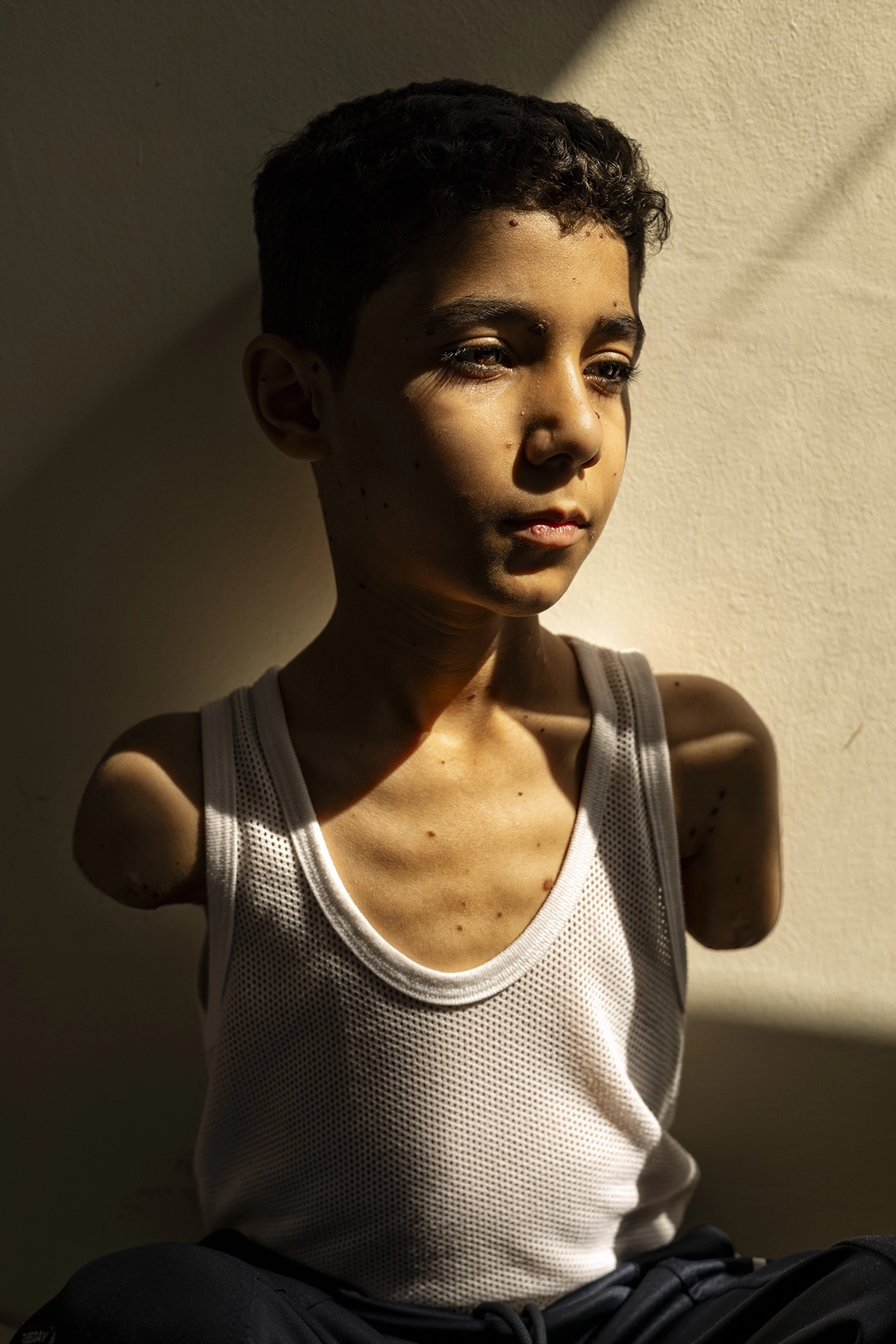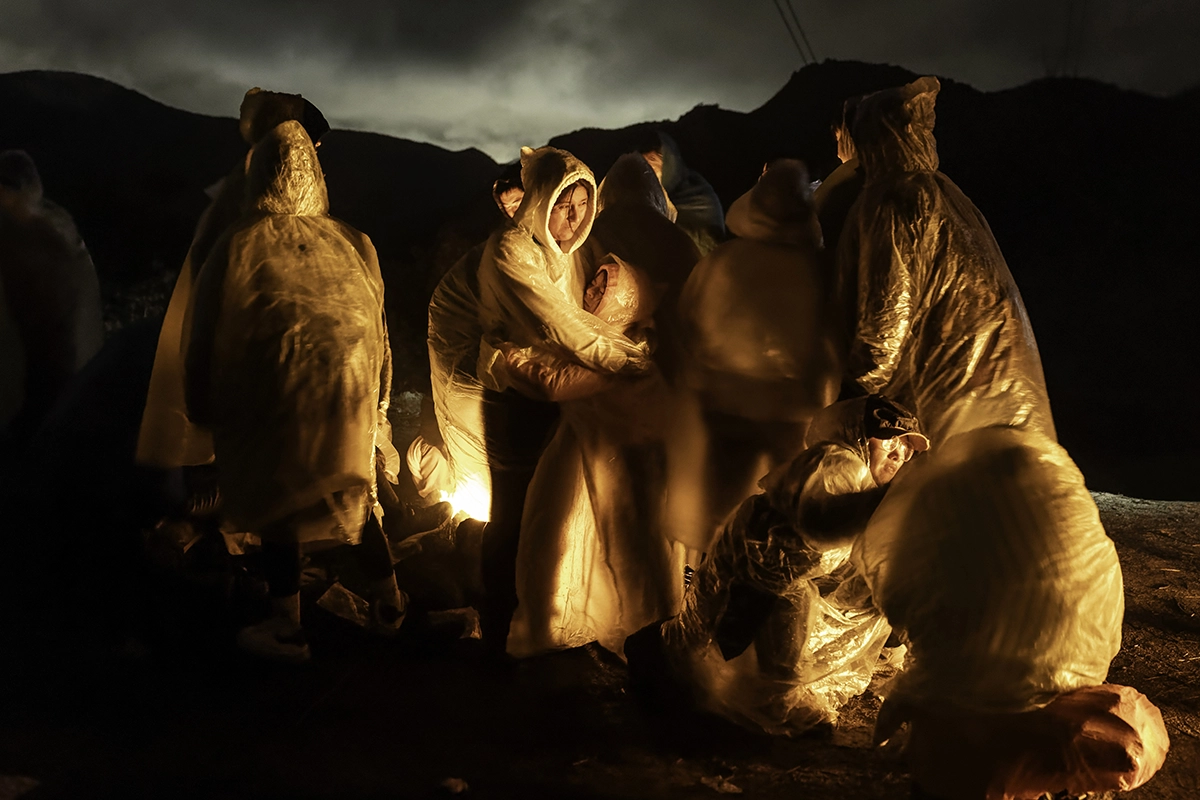World Press Photo today announces the Photo of the Year and two finalists of the 2025 World Press Photo Contest, showcasing a selection of the world’s best photojournalism and documentary photography.
The Photo of the Year winner for 2025 is a photo by Doha based Palestinian photographer Samar Abu Elouf, taken for The New York Times, of a young boy - Mahmoud Ajjour - severely injured while fleeing an Israeli attack in Gaza.

Mahmoud Ajjour, Aged Nine © Samar Abu Elouf, for The New York Times
Mahmoud Ajjour (9), who was injured during an Israeli attack on Gaza City in March 2024, finds refuge and medical help in Qatar. Doha, Qatar, 28 June 2024.
As his family fled an Israeli assault, Mahmoud turned back to urge others onward. An explosion severed one of his arms and mutilated the other. The family were evacuated to Qatar where, after medical treatment, Mahmoud is learning to use his feet to play games on his phone, write, and open doors. Aside from that, he needs special assistance for most daily activities, such as eating and dressing. Mahmoud’s dream is simple: he wants to get prosthetics and live his life as any other child.
The photographer, who is from Gaza and was herself evacuated in December 2023, lives in the same Doha apartment complex as Mahmoud in Qatar. She has bonded with families there, and documented some of the few badly wounded Gazans who made it out for treatment.
Children are disproportionately impacted by the war. The United Nations Works and Relief Agency (UNWRA) estimates that by December 2024, Gaza had more child amputees per capita than anywhere else in the world. From early on in the war, Qatar, which has been prioritizing and developing its healthcare system, mediated deals to evacuate critically injured people for treatment. By March 2025, more than 7,000 patients had been evacuated from Gaza for medical treatment, but at least 11,000 others remained there awaiting evacuation, according to the World Health Organization (WHO) The evacuees have been taken to countries including Egypt, Jordan, Qatar and Turkey.
Tens of thousands of others have been killed and more than 100,000 have been injured, according to the territory’s health authorities. The health system, decimated during the war, is ill-equipped to care for them: by March 2025, only 21 of Gaza’s 36 hospitals remain partly functional, according to the WHO.
Executive Director World Press Photo, Joumana El Zein Khoury said:
“This is a quiet photo that speaks loudly. It tells the story of one boy, but also of a wider war that will have an impact for generations. Looking at our archive, in the 70th year of World Press Photo, I am confronted by too many images like this one.
I remain endlessly grateful for the photographers who, despite the personal risks and emotional costs, record these stories to give all of us the opportunity to understand, empathise, and be inspired to action.
As we look ahead to the next 70 years, World Press Photo remains dedicated to supporting the photographers who risk everything to bring us the truth.”
Two finalists were selected as runners up alongside the Photo of the Year:

Night Crossing © John Moore, United States, Getty Images
Chinese migrants warm themselves during a cold rain after crossing the US–Mexico border. Campo, California, 7 March 2024.
Chinese immigrants constitute the third-largest immigrant group in the US, with unauthorized immigration from China to the US increasing significantly in the past two years. Encounters between unauthorized Chinese nationals and US Customs and Border Protection at the US-Mexico border surged from roughly 2,200 in 2022 to 38,200 in 2024, while encounters at the US-Canada border almost doubled from 6,700 to 12,400.
The surge in Chinese migrants has been fueled by escalating socioeconomic issues within China, compounded by prolonged waiting times for green cards and heightened scrutiny for work, student, and other long-term US visas for Chinese citizens. The absence of economic prospects and financial setbacks due to China's stringent zero-COVID policies prompted many Chinese migrants to seek opportunities elsewhere. Additionally, suppression of free speech and religious freedom have also contributed to emigration.
Social media platforms have played a significant role in this phenomenon, with video tutorials providing step-by-step guides on how to navigate the complexities of the US-Mexico border. These videos, often depicting successful border crossings, paint an alluring if misleading picture of life in the US.
This image, both otherworldly and intimate, depicts the complex realities of migration at the border, beyond statistics and media sensationalism. It highlights the desperation of those seeking a better life, while exposing the harsh realities for individuals, whose stories are often obscured by political rhetoric.

South America, Stories, Droughts in the Amazon © Musuk Nolte, Panos Pictures, Bertha Foundation
A young man brings food to his mother who lives in the village of Manacapuru. The village was once accessible by boat, but because of the drought, he must walk 2 kilometers along the dry riverbed of the Solimões River to reach her. Amazonas, Brazil, 5 October 2024.
Typically, water levels in the Amazon fluctuate between the rainy and dry seasons. However, this year's dry season has been particularly severe, causing critical drops in all major rivers across the Amazon basin. The ongoing drought is not merely a natural occurrence; it is closely linked to climate change.
According to Brazil's geological service, the Negro River at the port of Manaus measured just 12.66 meters at the beginning of October, far below its normal level of approximately 21 meters. This is the lowest recorded level since measurements began 122 years ago.
Declining water levels threaten the region’s rich biodiversity and disrupt vital river ecosystems. Local communities that rely on these rivers for fishing, transportation, and other livelihoods are facing severe hardships. Many have found themselves cut off, with their boats stranded on expansive sandbanks. As droughts intensify, many settlers face the difficult choice of abandoning their land and livelihoods for urban areas, changing the social fabric of this region permanently.
This project makes the effects of climate change, which can so often be abstract or difficult to represent, appear as a tangible and concrete reality shaping the futures of vulnerable communities closely connected with the natural world.
---
The awarded stories will be shown to millions as part of the World Press Photo annual traveling exhibition in over 60 locations around the world. Millions more will see the winning stories online.
Global jury chair, Lucy Conticello, Director of Photography for M, Le Monde's weekend magazine, said:
“When the global jury got down to selecting the different contenders for Photo of the Year we started with a wide selection from each of the six regions. Three topics emerged from that pool that define the 2025 World Press Photo edition: conflict, migration, and climate change. Another way of seeing them is as stories of resilience, family, and community.
The Photo of the Year is a portrait of a boy wearing a tank top; he's facing a window and a warm light shines on him casting a soft shadow on one side of his face. His young age, and beautiful features, are really in contrast with his melancholy expression. You then realize with a shock that he is missing his arms.
This young boy's life deserves to be understood, and this picture does what great photojournalism can do: provide a layered entry point into a complex story, and the incentive to prolong one's encounter with that story. In my opinion, this image by Samar Abu Elouf was a clear winner from the start.”
About press freedom:
According to the Committee to Protect Journalists, “The Israel-Gaza war has killed more journalists over the course of a year than in any other conflict CPJ has documented.” As of 4 April, 165 Palestinian, two Israeli, and six Lebanese have been killed, including cases where Palestinian journalists were allegedly targeted (read more).
Other countries with stories selected by the jury are also ranked low in Reporters Without Borders 2024 Press Freedom Index, including: Myanmar, Bangladesh, Sudan, Venezuela, and Russia.
The awarded stories will be shown to millions worldwide as part of World Press Photo’s annual traveling exhibition in over 60 locations around the world - including the world premiere exhibition in Amsterdam at De Nieuwe Kerk (18 April - 21 September); followed by London (23 May - 25 August); and Rome (6 May - 8 June), Berlin (6 June - 29 June); Vienna (12 September - 9 November); Budapest (10 September - 9 November); Mexico City (18 July - 28 September); Rio de Janeiro (27 May - 20 July); Montreal (27 August - 11 October); Jakarta (12 September - 11 October) and Sydney (24 May - 6 July).




